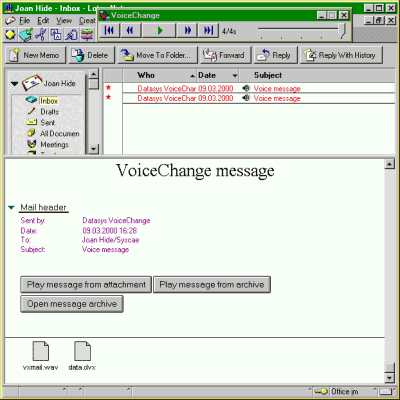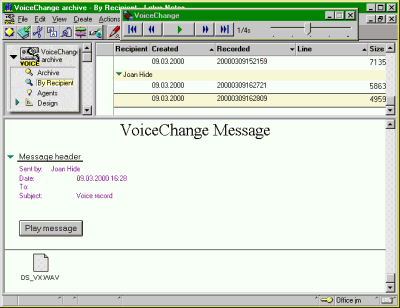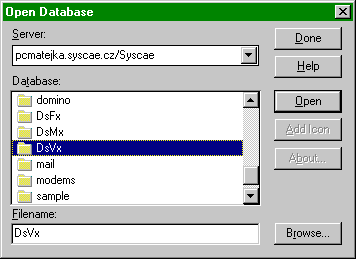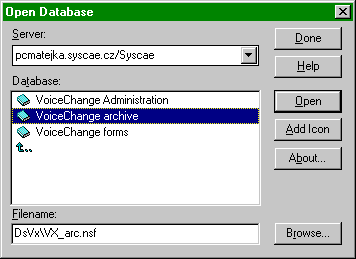|
|
Content of documentation | User documentation | Administrator documentation | Index of terms | Technical Support | Search on-line |
| Help for Lotus Notes users |
VoiceChange is integrated with the phone exchange and your e-mail system. Thus it enables, apart from collection of voice messages by phone, also receiving and processing the messages conveniently in your e-mail client (Microsoft Outlook, Lotus Notes...).
You need a phone machine with the tone dialing for getting of voice messages by phone. Nowadays, tone dial is used by most branch phones, pay stations and also mobile phones. Owners of older phone machines with the pulse dial can use special key pendants and apply them to the phone microphone.
| 1, #, hangup | Send message into appropriate voicebox. You can hear "Your message has been sent. Bye". |
| 2 | Replay just recorded message (for checking). |
| 3 | Record message again. |
| 4 | Set high/normal priority for the message (first press sets high priority, second one sets normal priority). |
| 5 | Change your phone number attached to message. Number is entered by phone keyboard and finished by hash. |
| 6 | Send message to more lines. Enter number using phone keyboard and press hash. You can enter more numbers or delete list of numbers. |
Sending the voice message:
Display the voice message received. The message text includes the information, from which line and from whom it has come (provided the caller comes from your branch exchange), and a reference to Help. Hereby you are notified of a new voice message.
If you have no sound card, it is necessary to collect the message by phone. You can find the description here.
If you have a sound card, you can play the message directly. Use the buttons "Play message from archive" and "Play message from attachment".
You have to be connected to computer network for proper effect of this function. Therefore, it cannot be used e.g. on notebooks for the "offline" reading of messages.
We recommend to use the function "Play message from archive" whenever possible.
This function does not mark the voice message as heard on the server; thus you will hear this message as a new one later, when collecting the messages by phone.
The button "Play message from attachment" is intended especially for the owners of notebooks working offline or via RAS.
By pressing button "Open message archive" you will open your voice mailbox on VoiceChange Server. Usage of this function is described bellow following image.

Incoming voice message. Click to zoom this image.

Voice mailbox - archive. Click to zoom this image.
You can see following information about every message in voice message list: date and time, when message was recorded and (if caller was from your PBX) caller phone number and name.
You can open any message and play its content via "Play message" button.
You do not delete a voice message from the server archive by deleting the received e-mail. You can delete a message from the archive by means of the following procedures:
Voice message are automatically deleted from the archive, too. After installation of VoiceChange it is preset that any non-heard message is deleted after sixty days, the heard messages after thirty days. Administrator may change the setup.
You can go to your voice mailbox archive from every voice message by
pressing a "Open message archive" button or you can directly open
Lotus Notes database with VoiceChange archive. It is stored on
VoiceChange home Notes server in file DsVx\VX_arc.nsf.
Connection can be done in following way:

Directory selection.

File selection.
| 1 | Jump to begin of the first message. |
| 2 | Forward message to other line. |
| 4 | Jump to begin of previous message. |
| 5 | Back to begin of message being played. |
| 6 | Jump to begin of next message. |
| 7 | Delete previous message. |
| 8 | Delete message being played. |
| 0 | Help. |
| * |
Stop playing new messages and go to the main menu.
Messages what weren't heard stay unheard and will be played next time. |
| 1 | Play all messages in your archive. During playback you can use the same keys as during playing new messages |
| 2 |
Change personal settings. Here are two other options: 2 - change password for your voicebox 3 - change your personal greeting. |
| 3 |
Delete all voice messages in your archive. Before proceeding you are asked for confirmation by pressing
hash. If you press it, all messages will be deleted including all unheard messages! Deleting can be
cancelled by pressing asterisk. Tip: individual messages can be deleted during playing them by pressing key 8. |
| 4 | Delete al new messages. Unlike from previous function it deletes only unheard messages. Confirmation by hash is also required. Action can be cancelled by asterisk. |
| 7 | Change company greeting. This feature is available only to VoiceChange administrator. |
| 8 | Leave message for other line. Allows to record message for different user. |
| 9 | Hear messages from other voice box. Enter number of different line and password for this line, then you will be allowed to access this voice box. |
| * | Terminate connection and hang up. |
| 1 | Hear personal / company greeting. |
| 2 | Record new greeting. Press hash to finish recording, then use this greeting by pressing hash again or deny it using asterisk. |
| 3 | Delete personal greeting (standard greeting will be used); switch company greeting on/off. |
| * | Back to the main menu. |